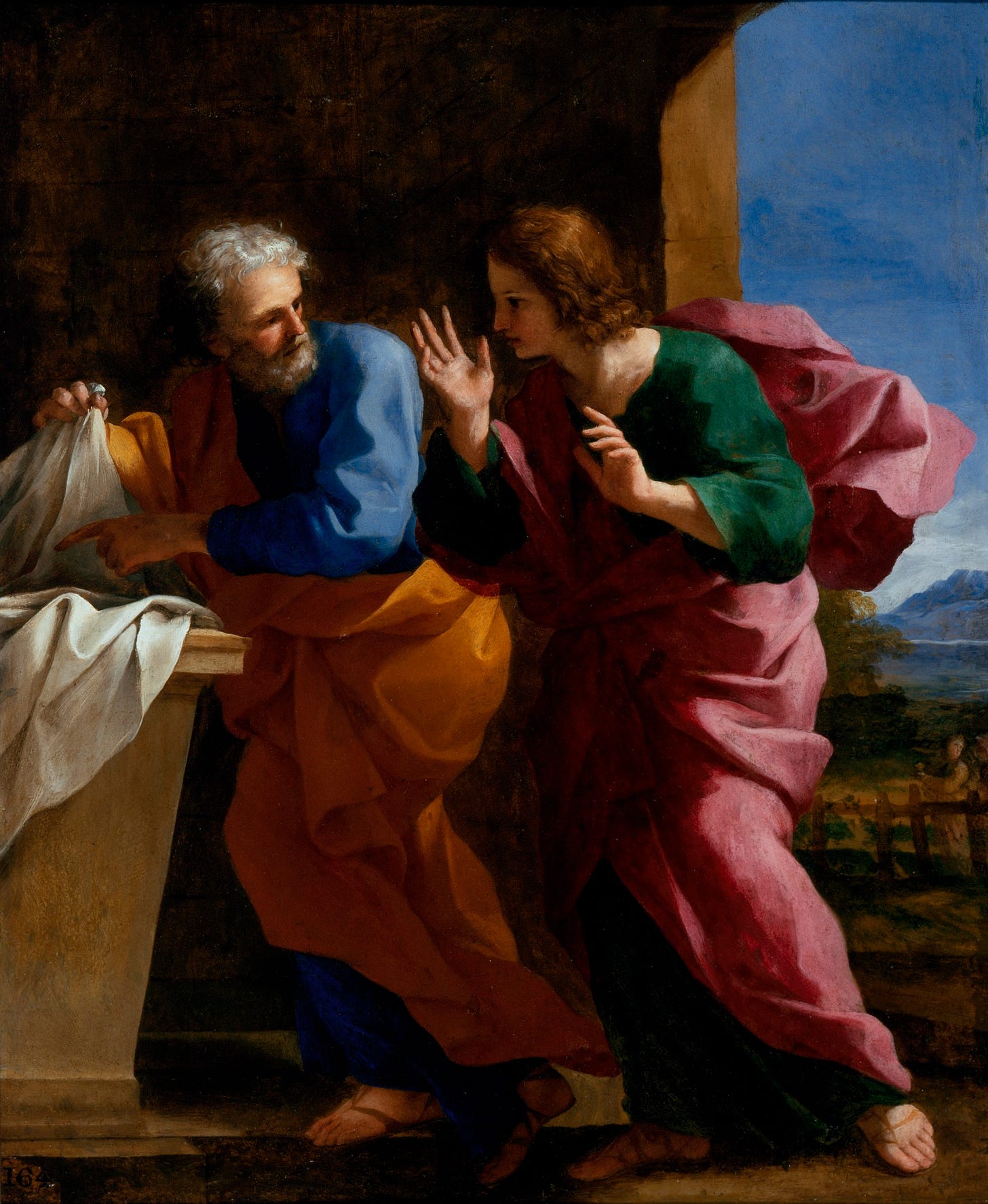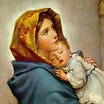In his beloved novel The Lord of the Rings, J.R.R. Tolkien implicitly touches upon a number of Catholic elements woven throughout the narrative. As we draw closer to Easter Sunday, let us examine the parallels between Saint John’s account of the Resurrection and Master Samwise’s awakening near the Field of Cormallen.
First, a brief recap is necessary. As you recall, Frodo and Sam destroy the One Ring thanks to Gollum’s greed. Overcome by his obsession with material wealth, poor Smeagol finally finds “his Precious”—only to fall from the peak of Mount Doom. Despite the success of their mission, however, the two hobbits find themselves “at the end of all things” with no hope of escape.[1] After inhaling an exorbitant amount of smoke, they fall unconscious at the foot of the mountain.
Similarly, the Passion and Death of Our Lord drove His Apostles and disciples to despair. All but Saint John—whom Samwise is a type of—fled from the so-called “scandal” of the Cross. Unlike the others, though, the Beloved Disciple remembered the words of His Master: “Destroy this temple, and in three days I will raise it up” (Saint John 2:21; Douay-Rheims Bible). Although he had yet to understand their significance, he, like Sam, stayed by his Master’s side until the very end. Similar to his hobbit-counterpart, the grief he felt after Christ’s crucifixion must have pierced the Beloved Disciple’s heart.
Imagine Saint John’s surprise, then, when Saint Mary Magdalene told him: “They have taken away the Lord out of the sepulchre, and we know not where they have laid him” (Saint John 20:2). Here, a small glimmer of hope shines in the heart of the Beloved Disciple. Along with Saint Peter, he sprints to the tomb. Out of respect for the Prince of the Apostles, Saint John waits to enter. When it’s his turn, he notices the meticulous arrangement of the burial cloths and believes in his Master’s Resurrection (Saint John 20:8).
In the same way, Samwise wakes to a wonderful surprise. Not only is he no longer in the hellish realm of Mordor, but “he was lying on some soft bed,” and the air was filled with the soothing fragrance of Ithilien.[2] Like Saint John, his amazement at this recent turn of events leads the young hobbit to conclude that he has to be dreaming—only to notice Frodo’s missing right ring finger! Not only is Sam overjoyed to find his Master unharmed, but even more shockingly, he comes face-to-face with the great wizard Gandalf “robed in white”.[3] Seeing Frodo unharmed beside him was a miracle in and of itself; meeting with a dead man was too much for Samwise to handle: “Is everything sad going to come untrue? What’s happened to the world?”[4]
Indeed, one can only dream of Saint John’s shock at seeing the Son of God literally walk through the entrance to the Upper Room. To quote the Angelic Doctor: “From Christ’s point of view the doors were shut so he could show them his power by entering through closed doors”.[5] To know about the Resurrection is one thing, but to watch a person pass through matter itself is a completely different story. Similar to Gandalf, Christ greets Saint John and the other Apostles in a reassuring manner: “Peace be to you” (Saint John 20:19). Just as Sam needed an explanation from the White Wizard, so, too, do the Apostles receive quite an intimate one from Our Lord: “And when he had said this, he shewed them his hands and his side” (Saint John 20:20). What sets the Son of God apart from any other “messianic” figure in literature is His vulnerability. We may hear characters or real-life soldiers talk about “battle scars,” but they often refer to their wounds out of pride. The Good Shepherd, on the other hand, can think of no other motive than to comfort His frightened sheep: “Jesus gives them sure proof that it is really himself by showing them his bands and side” (emphasis added).[6] When it comes to showing compassion, no one can surpass the Lamb of God. Consequently, like Sam, Saint John and the others are both consoled and glad (gavisi) to see their Master alive and well again (cf. Saint John 20:20).
Just when it looks like his day can’t get any better, Samwise finds out that the King awaits his company. The young hobbit is confused: “‘The King?’ said Sam. ‘What king, and who is he?’”[7] As Patrick Frazier notes, Jesus Christ is such an enigmatic figure that it takes Tolkien, not one, but three characters to typify Him: Frodo highlights Christ’s role as High Priest; Gandalf underscores Christ’s role as Prophet; and Aragorn, son of Arathorn II, emphasizes Christ’s role as King.[8] Samwise has already witnessed the resurrection of his beloved Master and the magical leader of the Fellowship of the Ring; now he must reunite with the rejuvenated heir of Arnor and Gondor. Thus, on the Field of Cormallen, the young hobbit’s transformative journey comes full-circle: “‘Well, if this isn’t the crown of all!’ he said. ‘Strider, or I’m still asleep!’[9]
In the final chapter of Saint John’s Gospel, the Beloved Disciple himself undergoes a similar encounter with the King of Kings on the Sea of Tiberias. After spending an entire night fishing, he and the other Apostles aren’t able to land a single catch. Eventually, the Son of God appears on the shore in disguise and bids them to “cast the net on the right side of the ship” (Saint John 21:6). When the Apostles listen to the stranger, they are rewarded with an overflowing net! Sensing his Master’s involvement in the miracle, Saint John says to Saint Peter: “It is the Lord” (Saint John 21:7). Like Sam, he, too, recognizes the son of a poor carpenter from Nazareth (Strider) as the King, not of one kingdom (Aragorn), but of Heaven and Earth. May we, like Saint John and Master Samwise, greet the Lord of Glory with grateful, fervent, and humble hearts!
The Catholic Corner is a new Substack publication dedicated to drawing people closer to Christ and the Catholic Church. Click here to join their family!
(Cover image source: Inger Edelfeldt, “The Crowning of Aragorn”: https://tolkiengateway.net/wiki/File:Inger_Edelfeldt_-_The_Crowning_of_Aragorn.jpg)
[1] J.R.R. Tolkien, The Lord of the Rings (HarperCollins e-books, 2009), book 6, chap. 3, 947.
[2] Tolkien, The Rings, 951.
[3] Ibid.
[4] Ibid.
[5] Saint Thomas Aquinas, Commentary on the Gospel of John, trans. Fr. Fabian Larcher, O.P. (Emmaus Academic, 2018) chap. 20, lect. 4, art. 2526, https://aquinas.cc/la/en/~Ioan.C20.L4.n2526.
[6] Aquinas, Commentary, chap. 20, lect. 4, art. 2533.
[7] Tolkien, 952.
[8] Patrick Frazier, “Examining Tolkien: The Return of the Priest, Prophet, and King,” Clarifying Catholicism, September 6, 2019, https://clarifyingcatholicism.org/articles/examining-tolkien-the-return-of-the-priest-prophet-and-king/#:~:text=Each%20of%20these%20roles%20is,serving%20as%20Christ%20the%20Prophet. Fun fact: Traditional Catholicism refers to these roles as Christ’s munera (offices).
[9] Tolkien, The Rings, 953.







What a marvelous analogy, so ably filled in with appealing detail!
"Overcome by his obsession with material wealth..."
Sorry, what? He wasn't obsessed with material wealth. He was enslaved to the power of Sauron's ring. Did you read the books at all?